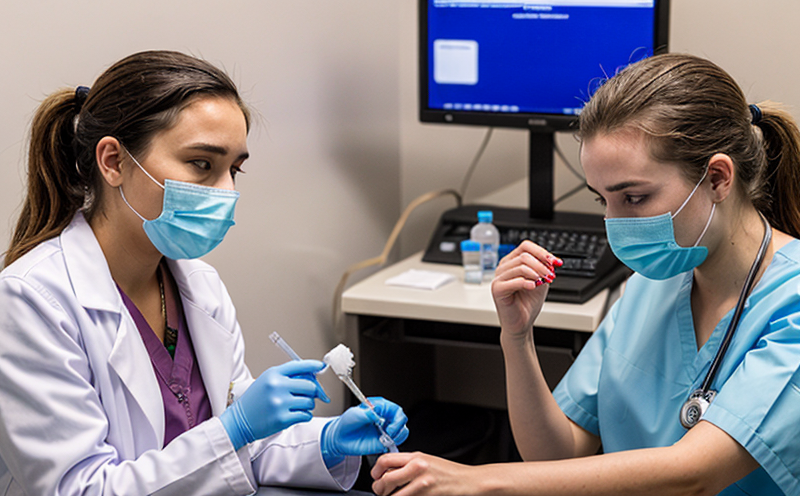CDC Mycobacterium tuberculosis Detection in Clinical Testing
The detection of Mycobacterium tuberculosis (Mtb) is a critical component in the diagnosis and management of tuberculosis (TB). This service adheres strictly to Centers for Disease Control and Prevention (CDC) guidelines, providing accurate and reliable detection methods that are essential in public health. The primary objective is to identify Mtb early in infected individuals to prevent its spread and inform appropriate treatment.
The clinical significance of Mycobacterium tuberculosis lies in its ability to cause TB, which remains a major global health concern. According to the World Health Organization (WHO), approximately 10 million new cases were reported globally in 2020. Early detection and effective treatment are crucial for reducing transmission rates, improving patient outcomes, and containing outbreaks.
The service offered here focuses on several key aspects: specimen collection, processing, identification techniques, and reporting. Specimen types include sputum, bronchoalveolar lavage fluid, and other relevant biological samples. Proper specimen handling is critical to ensure accurate results. The testing process involves multiple steps, including sample preparation, direct smear microscopy (if required), culture methods, and nucleic acid amplification tests (NAATs).
Direct microscopic examination using Ziehl-Neelsen staining or auramine-rhodamine fluorescence can be performed as a preliminary step to detect the presence of acid-fast bacilli. Culture on specialized media like Lowenstein-Jensen or Middlebrook 7H10 is essential for isolating and identifying Mtb. NAATs such as real-time polymerase chain reaction (PCR) assays are also used, especially in scenarios where rapid results are required.
The service employs advanced laboratory techniques that ensure high sensitivity and specificity. The use of standardized protocols and adherence to international standards like ISO 15189 contribute to the reliability of our results. Our team of highly trained microbiologists ensures consistent quality and accuracy.
Once identified, the isolate can be further characterized using molecular typing methods such as spoligotyping or MIRU-VNTR (Mycobacterial interspecies repetitive unit-variable number tandem repeat) analysis for epidemiological studies. This information helps in tracking the spread of drug-resistant strains and guiding public health interventions.
The service also provides comprehensive reporting, including identification of drug-susceptibility testing results if applicable. Understanding the drug resistance patterns is vital for selecting appropriate treatment regimens. Our laboratory ensures that all reports are delivered promptly to healthcare providers, enabling timely patient care.
Why It Matters
The detection and identification of Mycobacterium tuberculosis are crucial not only for individual patients but also for public health. Accurate diagnosis helps in the early initiation of appropriate treatment, which is key to preventing progression to active disease and reducing transmission rates.
- Early diagnosis allows for the commencement of antitubercular therapy, reducing morbidity and mortality associated with TB.
- Identification of drug-resistant strains aids in tailoring therapeutic strategies, thereby improving patient outcomes.
- Public health benefits include containment of outbreaks and reduction in healthcare costs by preventing unnecessary treatments.
The service aligns with global initiatives aimed at eradicating TB. By providing reliable diagnostic tools and services, we contribute to achieving the United Nations Sustainable Development Goal 3: Ensure healthy lives and promote well-being for all at all ages.
Scope and Methodology
Scope:
| Specimen Types | Testing Methods |
|---|---|
| Sputum, bronchoalveolar lavage fluid, other relevant biological samples. | Direct microscopic examination, culture methods, nucleic acid amplification tests (NAATs). |
Methodology:
| Step | Description |
|---|---|
| Specimen Collection | Collection of appropriate specimen based on patient history and clinical presentation. |
| Preparation | Processing specimens to optimize the detection of Mtb, including homogenization if necessary. |
| Detection | Use of direct smear microscopy (if required), culture on specialized media, and NAATs for rapid results. |
| Identification | Confirmation of Mycobacterium tuberculosis using biochemical tests and molecular typing methods if necessary. |
| Drug Susceptibility Testing (if required) | Determination of drug resistance patterns to guide appropriate treatment regimens. |
The methodology is designed to ensure a comprehensive approach to diagnosing tuberculosis, with a focus on accuracy and efficiency. We employ only the most reliable techniques and adhere strictly to CDC guidelines to provide accurate results.
Competitive Advantage and Market Impact
- Highly Experienced Team: Our team of microbiologists is highly skilled in diagnosing TB, with extensive experience in handling complex specimens.
- Advanced Technology: Utilization of cutting-edge technology ensures rapid and accurate results, crucial for patient care.
- Compliance and Standards: Adherence to international standards like ISO 15189 guarantees consistent quality and reliability.
- Rapid Turnaround Time: Our efficient processes allow for quick reporting of test results, enabling timely treatment interventions.
The service plays a pivotal role in the global fight against TB. By providing accurate and rapid diagnosis, we contribute significantly to public health efforts aimed at reducing the incidence and prevalence of tuberculosis worldwide.





